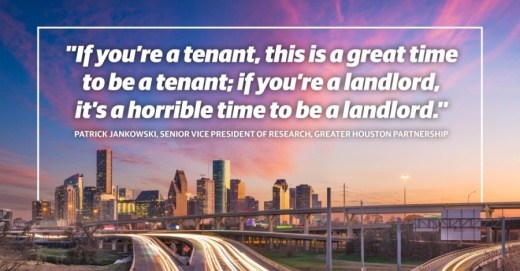“Whenever the economy enters a recession there is always a drop off in leasing activity, and office, industrial and retail space,” Jankowski said. “The problem is we entered this downturn where we already had a glut in office and a development glut and warehouse/industrial that is going to make things worse than it would have been otherwise.”
However, house building has stayed strong in part due to low interest rates and fewer job losses among those in higher income brackets who tend to be homebuyers, he said.
Office, industrial glut
While the Greater Houston area has seen a glut of office space for the last six years, Jankowski said the industrial buildup has happened more in the past year and a half.
The energy-related workforce has contracted by almost a third since the end of 2014, and because it was one of the prime leasers of office space in the Houston area, that contributed to the office glut, Jankowski said.
“The situation with industrial is it didn’t get out of hand until about 18 months ago, and in a normal market we can absorb maybe 8-10 million square feet of industrial space, but we have been building more than that for the last three years," Jankowski said. "A little over that is not a problem, but right now we’ve delivered close to 40 million square feet of industrial space ... and this is not a normal economy, so that makes it even worse.”
The Colliers International quarterly report on the Houston office market for the third quarter of 2020 shows a 21.3% overall vacancy rate—about a percentage point more than the previous year—but in several submarkets the change is larger. In The Woodlands, the vacancy rate in the third quarter of 2019 for office space overall was 9.5%, and in the third quarter of 2020 it was 15.1%.
Among the areas with the largest vacancy rate is the North Belt Greenspoint market, where Class A office space had a 60.5% vacancy rate in the third quarter of 2020. However, in the third quarter of 2019 it was 60.6%.
Jankowski said one effect he has seen when vacancies rise is termed the “flight to quality”—Class A buildings try to stay leased by offering deals to entice Class B renters.
“If you’re a tenant, this is a great time to be a tenant; if you’re a landlord, it’s a horrible time to be a landlord,” he said.
Multifamily housing
Another sector facing a glut in the Houston region is multifamily housing, he said.
“We are overbuilding in multifamily,” Jankowski said. “Over a two-year period, we’ll add close to 40,000 units to the market, and that’s about 40,000 more than we need.”
Jankowski said a typical rule of thumb is every six jobs created in Houston absorb about one apartment unit.
“So you can see that to absorb what we just built we need to create over 200,000 jobs,” he said. “And in this pandemic we are still down over 200,000 jobs.”
Market outlook
With the region having lost more than 200,000 jobs, it will take three to five years for those jobs to be replenished if they are replaced at a rate of 75,000 annually, he said.
“My outlook for the market, it’s going to be soft,” Jankowski said.
In the oil and gas sector, more than 90,000 jobs have been lost since 2014, he said. That sector is unlikely to see job gains at the same level as the losses because less labor is now needed as technology improves, he said.
“We get better at what we do at finding oil and gas; there’s less labor input and more technology input,” Jankowski said.
Technology jobs such as software, hardware and web-based services could see gains, he said. Research and development sectors are also areas to watch, he said.
The idea that people will shift to scenarios where they work from home is not likely to completely transform the market, however, he said.
“I think right now people are putting too much weight on the fact that we’ll all be working from home forever,” Jankowski said. “I think what’s going to happen is we’ll have a hybrid environment where we’ll spend some at home and some from the office. And when we are in the office we will still be needing social distancing ... so a company’s footprint will shrink, but it’s not going to shrink beyond zero.”





